For many, the name Tupperware conjures up images of colorful, interlocking plastic containers. But Tupperware is more than just a brand; it’s a household name synonymous with innovative kitchen storage solutions. Founded in 1942 by Earl Tupper, the company’s legacy is built on a core principle: keeping food fresh and flavorful for longer. Tupperware’s journey began with Earl Tupper’s relentless pursuit of a better way to store food, a quest that revolutionized not only kitchens but also the world of direct sales.

Earl Tupper, a self-taught engineer and chemist, wasn’t initially interested in kitchenware. He spent his early career in the manufacturing industry, working with plastics derived from wartime innovations. Disillusioned by the brittleness and unreliability of these early plastics, Tupper embarked on a mission to develop a more durable and versatile material. His tinkering in his Florida workshop led him to a discarded paint can – a seemingly mundane object that sparked a revolutionary idea. By experimenting with the polyethylene slag left over from the paint can’s manufacturing process, Tupper created a new kind of plastic: Poly-T. This flexible yet sturdy material proved ideal for crafting lightweight, airtight containers.
In 1946, Tupperware unveiled its first product – the “Wonder Bowl.” This seemingly simple bowl, crafted from Poly-T, boasted a revolutionary design. Unlike traditional containers, the Wonder Bowl featured a unique, airtight lid that locked onto the bowl with a satisfying snap. This ingenious invention, later known as the “Tupper Seal,” was the cornerstone of Tupperware’s success. The seal not only prevented leaks and spills but also created an airtight environment, significantly extending the shelf life of stored food.
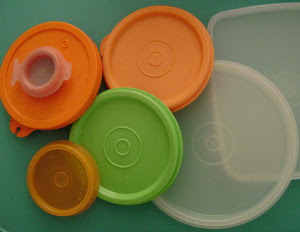
While the innovative containers were a game-changer, Tupperware’s true genius came with the introduction of its now-iconic party plan selling model in the 1950s. Brownie Wise, a charismatic saleswoman, recognized the potential of Tupperware beyond its functionality. She envisioned a social selling experience where women could gather in their homes, learn about the benefits of Tupperware products, and witness live demonstrations. Wise’s vision transformed homemakers into “Tupperware Ladies,” empowering them to become entrepreneurs and earn a commission on their sales. These social gatherings, filled with fun, product demonstrations, and a sense of community, became a hallmark of the Tupperware brand.
Tupperware’s story doesn’t end with the Tupperware Party. The company has consistently pushed the boundaries of food storage and preparation. From the modular nesting design that maximizes storage space to the introduction of microwave-safe containers, Tupperware has continuously adapted to meet the evolving needs of modern kitchens. In recent years, the company has embraced sustainability, introducing eco-friendly materials and promoting reusable products to reduce waste.
From its humble beginnings in Earl Tupper’s workshop, Tupperware has grown into a global phenomenon. The brand is now present in over 100 countries, offering a vast array of products that cater to diverse cultural preferences. Tupperware’s success lies in its ability to combine innovative design with a strong social selling strategy. It’s a company that not only transformed food storage but also empowered women and fostered a sense of community in homes around the world.
What’s new with Tupperware?
Tupperware is bringing back a bit of the past with a modern twist! Their Wonderlier Bowls and iconic food and drinkware sets are getting a refresh, allowing you to enjoy the nostalgia of those beloved Tupperware products with a contemporary feel. This focus on vintage design reflects a wider trend of consumers appreciating classic styles.
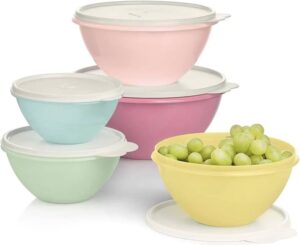
But Tupperware isn’t just looking back. They also remain committed to sustainability. Their Reduce-Reuse-Recycle model encourages you to get the most out of your Tupperware containers, and they offer recycling programs for old ones that have reached the end of their usable life. This focus on environmental responsibility is sure to resonate with eco-conscious consumers.
Finally, Tupperware continues to innovate in the kitchen. They’ve recently released several new products, including the Servalier Bowl in various sizes, Vent N Serve containers for controlled steaming, and Modular Mates containers with improved sealing. Whether you’re looking for the perfect container to store leftovers or a handy solution for meal prep, Tupperware has something new to offer.
Target Audience of Tupperware
Traditionally, Tupperware has focused on attracting women aged 25-50 who are interested in healthy living and sustainability. This demographic aligns with people who are good habits lifestyle shoppers and appreciate products that promote reducing waste and reusing items. For instance, environmentally conscious consumers might be drawn to Tupperware’s commitment to reusability and their Reduce-Reuse-Recycle model.
In addition to demographics, Tupperware uses psychographic segmentation to target homemakers and mothers. This strategy is evident in their Tupperware parties, which have been a staple of their marketing for decades. These social gatherings allow potential customers to experience the products firsthand in a casual setting that caters to the needs of busy families.
While Tupperware has a strong focus on families, it’s important to note that their target audience has broadened in recent years. Their product range now caters to a wider range of consumers, including teens and working professionals. This is reflected in their marketing efforts, which have become more inclusive.
Marketing Strategies of Tupperware
Tupperware is a globally recognized brand that specializes in household products, particularly plastic food storage containers and kitchenware. Over the years, Tupperware has employed various marketing strategies to promote its products and build brand loyalty. Here’s an overview of some of the key marketing strategies employed by Tupperware:
1. Direct Selling Model
Tupperware leverages a direct selling model to reach its customers. This strategy bypasses traditional retail stores and focuses on direct interactions between salespeople and consumers. In-home parties are a cornerstone of this approach, allowing Tupperware’s salesforce to demonstrate products and explain their functionalities to potential buyers in a comfortable setting. This personalized touch ensures customers understand the best ways to use Tupperware products, maximizing their value.
To streamline operations, Tupperware utilizes a three-tier network structure. This tiered system simplifies management and incentivizes sales. Additionally, Tupperware embraces the power of social media through social selling. Sales consultants can leverage platforms like Facebook, Instagram, and WhatsApp to connect with existing and potential customers. Social selling allows for wider reach and targeted marketing efforts.
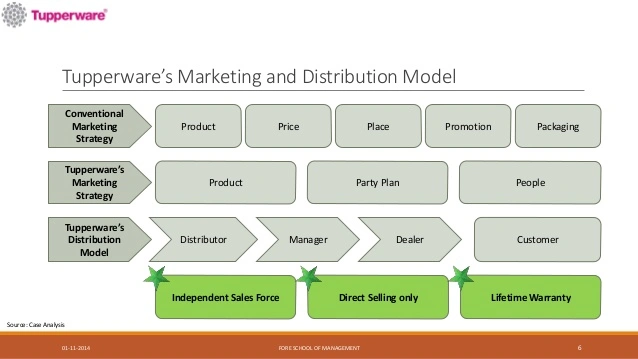
While the direct selling model reigns supreme, it’s important to note that Tupperware also employs a wholesale channel.Wholesalers purchase Tupperware products in bulk and then distribute them to various retailers across the globe. This approach caters to a broader audience seeking Tupperware products in traditional retail settings.
2. Product Quality and Innovation
Tupperware has cultivated a reputation for exceptional product quality. Durable materials like LDPE and PP ensure their containers are safe for repeated use and dishwasher-friendly. Airtight seals promote optimal food preservation, minimizing waste and extending the lifespan of fresh ingredients. This focus on durability and functionality translates to a cost-effective solution for consumers, who can rely on their Tupperware containers for years to come.
Innovation is another cornerstone of Tupperware’s marketing strategy. The company continuously develops new and improved products to address changing consumer needs. This can be seen in their wide range of shapes, sizes, and colors, catering to diverse food storage requirements. Additionally, Tupperware explores sustainable solutions, with involvement in initiatives using recycled plastic waste for raw materials. Their commitment to reducing food waste and energy consumption resonates with environmentally conscious consumers, further solidifying their brand image. In 2019, Tupperware introduced ECO+, a new material that uses mixed plastic waste otherwise destined for incineration or landfill. The use of this initial circular material has resulted in the avoidance of more than 100 tons of CO2 emissions from diverted waste that would otherwise be landfilled.
By prioritizing quality and innovation, Tupperware has established itself as a trusted brand in over 100 countries. Their design-driven approach offers a variety of food preparation, storage, and serving solutions. This commitment to excellence ensures their products remain relevant across cultures and meet the evolving demands of a global audience.
3. Multi-Channel Distribution
Tupperware has embraced a multi-channel distribution strategy, offering customers a variety of convenient shopping options. This includes physical retail locations, allowing for in-person product interaction, and online marketplaces for easy browsing and purchasing. Flexibility is key, catering to diverse consumer preferences. Whether a customer enjoys the social aspect of physical stores or prefers the ease of online shopping, Tupperware provides a seamless experience.
Multi-level marketing (MLM) is another facet of Tupperware’s strategy. An established network of distributors and brand representatives fosters brand growth. These individuals act as communicators, generating positive word-of-mouth promotion through in-home Tupperware demo parties. This personalized approach allows for product demonstrations, building trust and customer loyalty.
Tupperware’s webstore serves as a central hub for all their products. Customers can explore the entire range with detailed information, including utility and demonstration videos. Recipes and other resources further enhance the user experience. This digital platform complements the traditional channels, creating a comprehensive and accessible shopping journey.
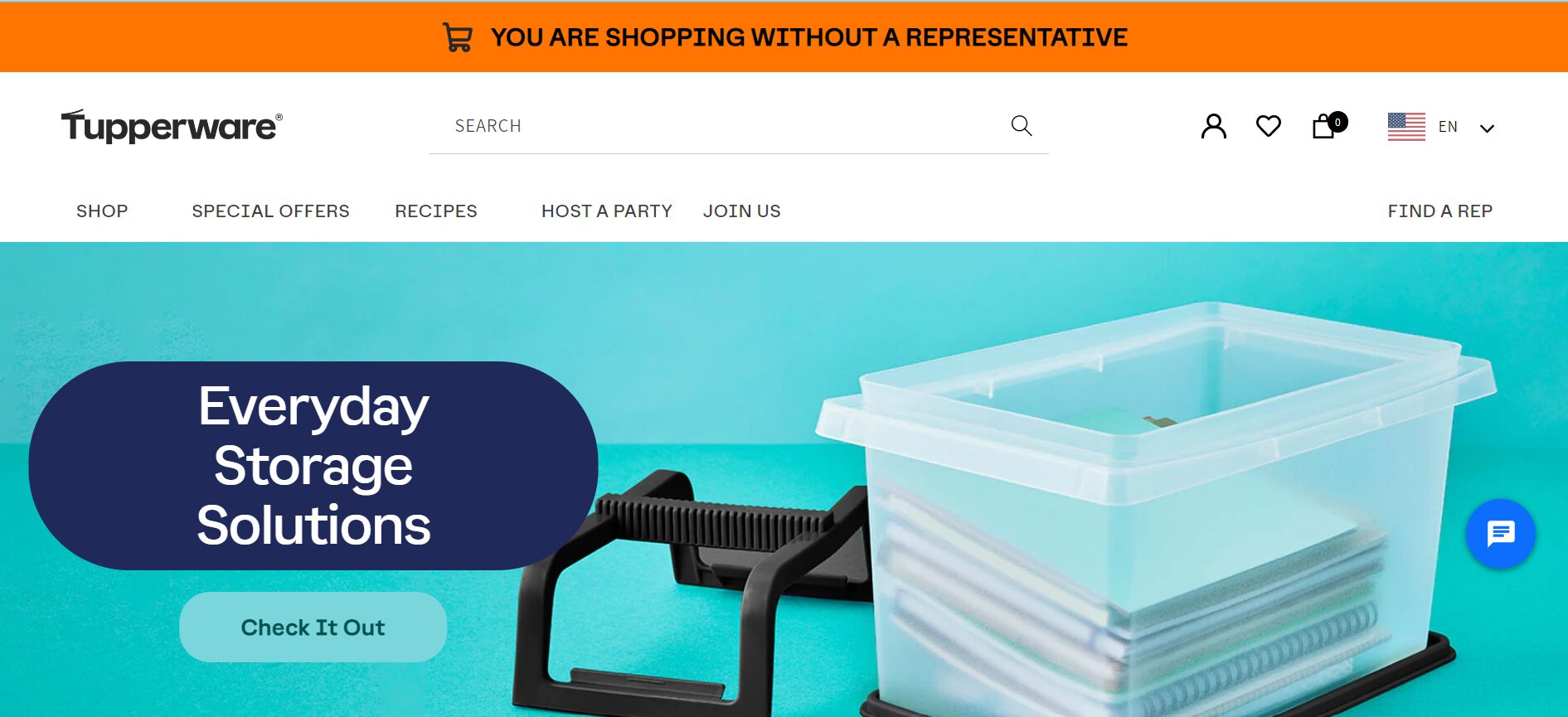
4. Social Media Marketing
Tupperware has transformed social media into a powerful tool to strengthen its direct-selling channel and foster deeper customer connections. Sales consultants are equipped with platforms like Facebook, Instagram, and WhatsApp to directly reach existing and potential customers. This allows for product demonstrations, personalized interactions, and targeted marketing efforts. Social media becomes a virtual extension of the in-home party experience, promoting existing products and creating excitement around new releases.
Tupperware’s social media strategy prioritizes forging personal connections with its audience. Engaging campaigns developed with partners like Pulp Strategy keep customers interested. Influencer marketing taps into the reach and trust established by personalities in parenting, food, and lifestyle categories. Additionally, entertaining and educational content, like posts, videos, and blog entries, fuels engagement and encourages sharing, further expanding their reach and brand awareness.
5. Cause Marketing and Corporate Social Responsibility
Tupperware recognizes the importance of corporate social responsibility (CSR) and leverages it as a powerful marketing strategy. Their commitment extends beyond profit, actively supporting environmental and social causes. This resonates with environmentally conscious consumers and strengthens brand image.
Tupperware’s CSR efforts go beyond mere statements. Partnering with organizations like Zomato Feeding India exemplifies their dedication. Donating containers for food storage and generating funds for community fridges directly addresses issues of hunger and food waste. Similarly, their support for the National Park Foundation’s sustainability program demonstrates a commitment to environmental well-being. Funding water refill stations in national parks showcases their dedication to environmental conservation.
Tupperware’s impact extends beyond the environment. The company has empowered millions of Indian women to become financially independent entrepreneurs through their direct selling model. This fosters community building and celebrates female entrepreneurship. By investing in opportunity enrichment and uplifting relationships, Tupperware creates a positive social impact while fostering brand loyalty among women.
Overall, Tupperware’s marketing strategies revolve around delivering high-quality products, fostering personal connections with consumers, embracing digital channels, and demonstrating a commitment to social responsibility. Through these efforts, Tupperware continues to strengthen its brand presence and drive sales worldwide.
Marketing Mix of Tupperware
Tupperware’s enduring success can be attributed in part to its strategic use of the marketing mix, also known as the 4Ps. Let’s delve into each element and explore how Tupperware has mastered them:
1. Product:
Variety and Innovation: Tupperware offers a vast array of products, from food storage containers to kitchen tools, microwave cookers, and servingware. They constantly innovate, introducing new designs, functionalities, and materials to cater to evolving consumer needs.
Durability and Quality: A core aspect of the brand is the exceptional quality and durability of their products. Tupperware containers are known to last for years, becoming a reliable staple in kitchens.
Aesthetics and Functionality: Tupperware products are not just functional, they’re aesthetically pleasing. They come in a variety of colors and designs, making them a fashionable addition to any kitchen.
Stackability and Space-Saving: Many Tupperware products are designed to nest or stack efficiently, maximizing storage space in kitchens.
2. Price:
Value Pricing: Tupperware products are positioned as a long-term investment. While the initial price point might be slightly higher than disposable options, the extended lifespan and quality justify the cost.
Premium Perception: The focus on quality and durability fosters a perception of premium value for Tupperware products. Customers are willing to pay a bit more for a product they know will last.
Discounted Bundles and Promotions: Tupperware frequently offers bundle deals, discounts, and promotions to incentivize purchases and introduce new products. These strategies make their products more accessible to a wider range of customers.
3. Place (Distribution):
Direct Selling Network: Tupperware’s primary distribution channel is its network of independent sales representatives who host in-home parties. This allows for product demonstrations, personalized recommendations, and building relationships with customers.
Strategic Partnerships: Tupperware also partners with select retailers to offer a curated range of products in brick-and-mortar stores. This expands their reach and caters to customers who prefer a traditional shopping experience.
Online Sales: Tupperware has embraced online sales through their website and partnerships with e-commerce platforms. This caters to the growing trend of online shopping and offers convenience to customers.
4. Promotion:
Party Atmosphere and Social Selling: Tupperware parties create a fun and social environment where people can learn about the products, experience demonstrations, and connect with friends. This fosters a sense of community and encourages sales.
Incentive Programs and Rewards: Tupperware sales representatives and customers are incentivized through rewards programs and commission structures. This motivates sales and encourages repeat business.
Word-of-Mouth Marketing: The focus on in-home parties and social interaction fosters strong word-of-mouth marketing. Satisfied customers become brand advocates, sharing their positive experiences and driving organic growth.
Digital Marketing: Tupperware leverages social media platforms and targeted online advertising to reach a wider audience, showcase product benefits, and create brand awareness.
By effectively managing these elements, Tupperware has established itself as a leading brand in the food storage and kitchenware industry. Their strategic marketing mix has been instrumental in building brand loyalty, driving sales, and ensuring long-term success.
Porter’s Five Forces of Tupperware
Michael Porter’s Five Forces framework helps analyze the competitive environment of an industry. Let’s see how each force impacts Tupperware:
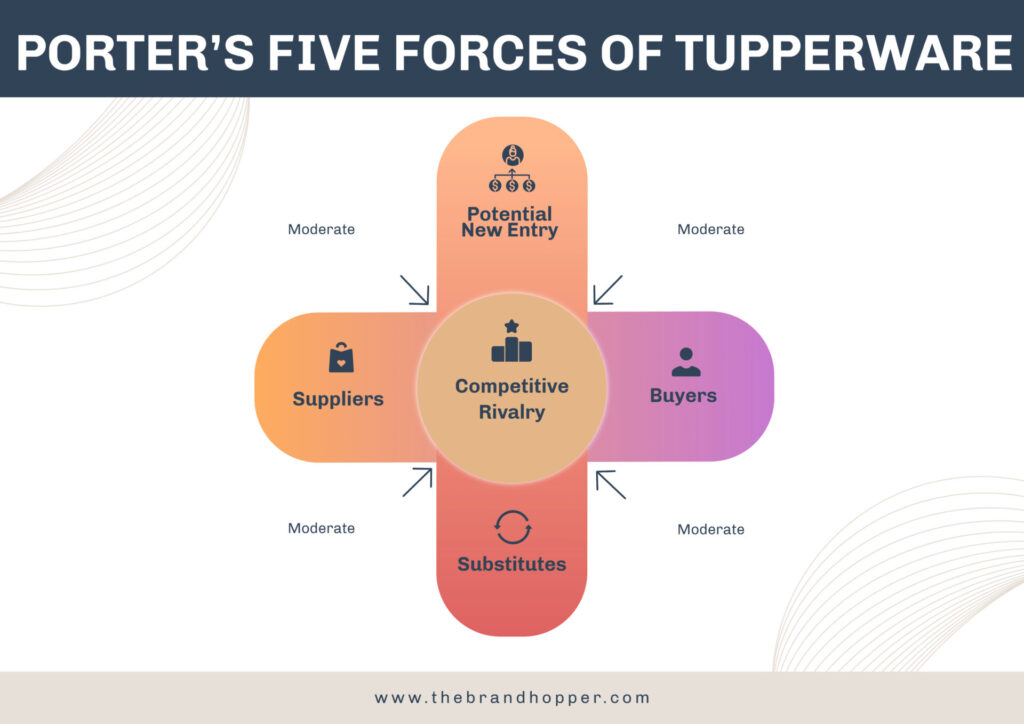
1. Threat of New Entrants (Moderate Force):
High Capital Requirements: Setting up manufacturing facilities, building brand recognition, and establishing a distribution network require significant capital, making entry difficult for new players. This is a positive for Tupperware.
Economies of Scale: Existing players like Tupperware benefit from economies of scale, achieving lower production costs per unit due to their high volume. This advantage discourages new entrants.
Brand Loyalty and Distribution Channels: Tupperware’s established brand loyalty and strong relationships with sales representatives create barriers for new entrants to gain market share.
2. Bargaining Power of Suppliers (Moderate Force):
Multiple Raw Material Suppliers: Tupperware sources plastic resins and other materials from various suppliers, reducing dependence on any single one. This limits supplier bargaining power.
Standardized Materials: The plastic materials used are generally standardized, allowing Tupperware to negotiate competitive prices with suppliers.
3. Bargaining Power of Buyers (Moderate Force):
Large and Fragmented Customer Base: Tupperware caters to a vast and diverse customer base. Individual buyers have minimal leverage in price negotiations.
Availability of Substitutes: Consumers have various options for food storage containers and kitchenware, giving them some bargaining power. However, Tupperware’s brand recognition and focus on quality can mitigate this to some extent.
4. Threat of Substitutes (Moderate Threat):
Wide Range of Substitute Products: Glass, metal, and disposable containers can all serve similar purposes to Tupperware products.
Focus on Differentiation: Tupperware emphasizes its unique selling points like durability, space-saving designs, and functionality to differentiate itself from substitutes.
5. Competitive Rivalry within the Industry (Strong Force):
Numerous Competitors: The housewares and food storage industry is crowded with competitors like Rubbermaid, Lock & Lock, and national brand retailers offering their own storage solutions.
Innovation and Price Competition: Companies constantly innovate with new features and designs, and compete fiercely on price. This is a major challenge for Tupperware.
While some forces provide Tupperware with advantages, the strong competitive rivalry within the industry demands constant innovation, strategic marketing, and focus on customer value to maintain market share.
Competitor Analysis of Tupperware
Tupperware, a household name synonymous with innovative food storage solutions, faces competition from various fronts. Here’s a detailed breakdown of its key competitors:
Direct Competitors:
1. Rubbermaid
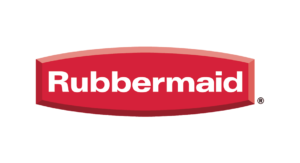
A major competitor offering a broad range of food storage containers, kitchen tools, and organization solutions.
- Strengths: Competitive pricing, wide product range, brand recognition.
- Weaknesses: Less emphasis on in-home demonstrations and social selling compared to Tupperware.
2. Lock & Lock

Known for their secure locking mechanisms and innovative designs.
- Strengths: Focus on leak-proof containers, good quality at competitive prices.
- Weaknesses: Limited brand recognition compared to Tupperware, less established distribution network.
3. Gladware

A subsidiary of The Clorox Company, offering disposable and reusable food storage containers.
- Strengths: Affordability, convenience of disposable options.
- Weaknesses: Focus on disposables creates a perception of lower quality compared to Tupperware’s emphasis on durability.
Indirect Competitors:
1. National Brand Retailers:
Major retailers like Walmart and Target offer their own private-label brands of food storage containers, often at lower price points.
- Strengths: Wider availability, affordability.
- Weaknesses: Inconsistent quality, less focus on innovation and design.
2. Glass and Metal Container Manufacturers:
Companies specializing in glass and metal containers offer a more sustainable alternative to plastic.
- Strengths: Eco-friendly perception, perceived health benefits of glass and metal.
- Weaknesses: Heavier and more prone to breakage compared to plastic, may not be suitable for all storage needs.
By proactively addressing these challenges and capitalizing on its strengths, Tupperware can ensure its position as a leader in the food storage and kitchenware industry.
Success Factors of Tupperware
Tupperware’s enduring presence in the housewares market can be attributed to a potent blend of factors that have secured its position as a leader. Let’s delve into the key ingredients that have contributed to their success:
1. Innovative and High-Quality Products:
Durability and Functionality: At the core of Tupperware’s success lies its unwavering commitment to quality. Their products are designed to last for years, offering exceptional durability and functionality. This resonates with consumers seeking long-term value.
Constant Product Development: Tupperware isn’t content with resting on its laurels. They constantly innovate, introducing new features, designs, and product lines to cater to evolving consumer needs and preferences.
Focus on Multi-functionality and Space-Saving: Tupperware understands the importance of maximizing space in modern kitchens. Their products are often designed to serve multiple purposes and stack efficiently, addressing a practical concern for many consumers.
2. Empowering Direct Selling Network:
The Power of In-Home Parties: Tupperware’s unique selling strategy revolves around in-home parties. This social selling approach allows for product demonstrations, personalized recommendations, and relationship building with customers. It fosters a sense of community and creates a fun, interactive experience that traditional retail struggles to replicate.
Empowered Sales Force: Tupperware’s network of independent sales representatives is the backbone of their success. These individuals are incentivized through commissions and rewards programs, motivating them to build relationships and drive sales.
3. Building Brand Loyalty and Customer Satisfaction:
Focus on Value and Long-Term Savings: While the initial cost of Tupperware products might be higher than disposable options, the emphasis is on their long-lasting quality and functionality. This translates to value for money in the long run, fostering customer satisfaction and loyalty.
Exceptional Customer Service: Tupperware prioritizes excellent customer service, ensuring product satisfaction and addressing any concerns promptly. This builds trust and encourages repeat business.
4. Adaptability and Strategic Marketing:
Embracing Digital Transformation: Tupperware recognizes the growing importance of online shopping. They have effectively integrated their direct selling model with digital platforms and social media to reach a wider audience and enhance customer experience.
Strategic Partnerships: Tupperware strategically partners with select retailers to offer a curated range of products in brick-and-mortar stores. This expands their reach and caters to customers who prefer a traditional shopping experience.
5. Building a Sustainable Future:
Tupperware is increasingly focusing on eco-friendly materials and sustainable practices in response to growing consumer concerns about the environment. This demonstrates their commitment to responsible manufacturing and resonates with environmentally conscious consumers.
Tupperware’s success story is a testament to the power of a well-defined strategy, high-quality products, and a customer-centric approach. By constantly innovating, empowering their sales force, and adapting to changing market trends, Tupperware has secured its place as a household name and a leader in the food storage and kitchenware industry. Their ability to navigate challenges and embrace new opportunities will be crucial for their continued success in the years to come.
Also Read: Ziploc: A Deep Dive into History, Technology, and Marketing
To read more content like this, subscribe to our newsletter



